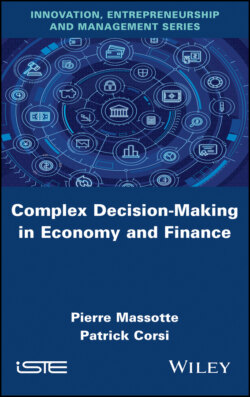Читать книгу Complex Decision-Making in Economy and Finance - Pierre Massotte - Страница 13
I.3.1. Factors that cause complexity
ОглавлениеIn our society, a cohort of factors lead to ever greater complexity. They are linked to certain levers such as globalization, demographics, consumer profiles and expectations, natural resources, the environment, regulations and militant protests [LAU 05]. Currently, when we analyze a socio-economic system, we do not yet know to which destiny it will converge:
– Towards a patchwork world?
– Towards a complex community of dungeons and fortresses?
– Towards a world of communities with open borders?
This actually is a question of entropy. Entropy being everywhere, and the second principle of thermodynamics which governs our environment, it stipulates that entropy – generally associated with the concept of disorder, randomness, or lack of structure and organization – is continuously increasing. Thus, we cannot predict what the future will be, either in terms of molecules, living organisms, our consciousness, business evolution, etc. Nevertheless, we know that some limits exist, since, for instance, black holes in the universe already possess a huge amount of entropy. Moreover, by analogy, in business there are also dark environments or dark information that are able to modify part of the entropy sources, and then able to delay the emergence and occurrence of a deterministic and unpredictable chaos.
Practically, in each scenario, the consequences are multiple and can concern the integrity of countries, the development of terrorism or wars, industrial and information systems insecurity, the acceleration of research and development and so on. But we cannot know in advance the importance of these impacts. On the contrary, in this complexity process, it is possible to control the evolution of certain factors such as:
– the number of parameters to be considered;
– the gradual shift from an information-based society to a knowledge-based society and, in the future, to a society based on awareness and on relationships;
– the organizational model. The fluidity of a society based on the sharing of information, knowledge and know-how requires the networking of the various actors in a same economic model, of the same community of interest, which becomes the driving force of growth.
The increase in complexity can be observed in these socio-economic systems, where globalization remains an overall trend. The telecommunications industry is at the core of the need for sharing knowledge and expertise, and its backbone is the Internet and the Web. On the way, the Peer-to-Peer model is the preferred catalyst. As for the supply chain, it operates in increasingly open, international and transnational modes and includes more network partners, thus more complexity. In all these situations, it is the user who places himself at the center of the systems and who induces, in a relatively autonomous way, the interrelationships between the set of users.
Within our developed societies, the impact of connected user populations on complexity has now become paramount. Their accumulated effect induces a resulting chaotic behavior and turbulence. A simple example, the MP3 audio compression and transmission standard, having been adopted off-market by masses of autonomous users, led to the advent of a collective lifestyle adapted to these same masses within less than a decade. There has been no shortage of turbulence, particularly with regard to institutions that owned audio content or are in charge of distribution: they are threatened by the new modes of sharing and expression. Knowledge society is highlighting the semantics of the interrelation of these autonomous agents. The marketing of the knowledge society is now capable of understanding market turmoil, in particular its emergence, growth models, dissolution, competitive ecology, cooperation schemes (tailor-made partnerships and alliances), technology substitution models and their extinction and so on. The MP3 battle was a business model for other players to come into play, based on the shift from the traditional logistical supplier/distributor pair to the polar “influencer”/consumer pair. The first model punctuates the existence of suppliers and users by opposing them. The second model instead emphasizes the ability to prescribe, therefore influence, through a network of influence, and this transcends the previous duality. The influencer is accredited by the network because the consumer becomes a source of creation. The values created are very diverse: they concern knowledge, the economy (values and wealth that make it possible to materialize acts of creation and innovation), technology (which calls for more technology), etc. In the case of knowledge, for example, value is created from available information and data. Since the consumer-customer is at the center of the system, it is, in the same way, a source of complexity for the resulting system.
